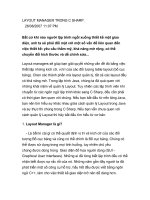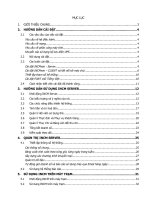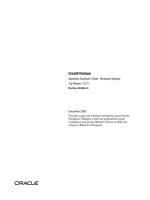Chapter-12-The Vinum Volume Manager
Bạn đang xem bản rút gọn của tài liệu. Xem và tải ngay bản đầy đủ của tài liệu tại đây (225.43 KB, 22 trang )
10 April 2003, 06:13:07 The Complete FreeBSD (vinum.mm), page 221
12
The Vinum Volume
Manager
In this chapter:
• Vinum objects
• Creating Vinum
dr ives
• Star ting Vinum
• Configur ing Vinum
• Vinum configuration
database
• Installing FreeBSD
on Vinum
• Recovering from
dr ivefailures
• Migrating Vinum to a
newmachine
• Things you shouldn’t
do with Vinum
In this chapter:
• Vinum objects
• Creating Vinum
dr ives
• Star ting Vinum
• Configur ing Vinum
• Vinum configuration
database
• Installing FreeBSD
on Vinum
• Recovering from
dr ivefailures
• Migrating Vinum to a
newmachine
• Things you shouldn’t
do with Vinum
Vinum is a Volume Manager,avirtual disk driverthat addresses these three issues:
• Disks can be too small.
• Disks can be too slow.
• Disks can be too unreliable.
From a user viewpoint, Vinum looks almost exactly the same as a disk, but in addition to
the disks there is a maintenance program.
Vinum objects
Vinum implements a four-levelhierarchyofobjects:
• The most visible object is the virtual disk, called a volume.Volumes have essentially
the same properties as a UNIX disk drive,though there are some minor differences.
Theyhav e no size limitations.
• Volumes are composed of plexes,each of which represents the total address space of
avolume. This levelinthe hierarchythus provides redundancy. Think of plexesas
individual disks in a mirrored array,each containing the same data.
• Vinum exists within the UNIX disk storage framework, so it would be possible to use
UNIX partitions as the building block for multi-disk plexes, but in fact this turns out
vinum.mm,v v4.19 (2003/04/09 19:56:42) 221
222 Chapter 12: The Vinum Volume Manager
10 April 2003, 06:13:07 The Complete FreeBSD (../tools/tmac.Mn), page 222
to be too inflexible: UNIX disks can have only a limited number of partitions.
Instead, Vinum subdivides a single UNIX partition (the drive)into contiguous areas
called subdisks,which it uses as building blocks for plexes.
• Subdisks reside on Vinum drives,currently UNIX partitions. Vinum drivescan
contain anynumber of subdisks. With the exception of a small area at the beginning
of the drive,which is used for storing configuration and state information, the entire
drive isavailable for data storage.
Plexescan include multiple subdisks spread overall drivesinthe Vinum configuration, so
the size of an individual drive does not limit the size of a plex, and thus of a volume.
Mapping disk space to plexes
The way the data is shared across the driveshas a strong influence on performance. It’s
convenient to think of the disk storage as a large number of data sectors that are
addressable by number,rather likethe pages in a book. The most obvious method is to
divide the virtual disk into groups of consecutive sectors the size of the individual
physical disks and store them in this manner,rather likethe way a large encyclopaedia is
divided into a number of volumes. This method is called concatenation,and sometimes
JBOD (Just a BunchOfDisks). It works well when the access to the virtual disk is
spread evenly about its address space. When access is concentrated on a smaller area, the
improvement is less marked. Figure 12-1 illustrates the sequence in which storage units
are allocated in a concatenated organization.
0
1
2
3
4
5
6
7
8
9
10
11
12
13
14
15
16
17
Disk 1 Disk 2 Disk 3 Disk 4
Figure12-1: Concatenated organization
An alternative mapping is to divide the address space into smaller,equal-sized
components, called stripes,and store them sequentially on different devices. For
example, the first stripe of 292 kB may be stored on the first disk, the next stripe on the
next disk and so on. After filling the last disk, the process repeats until the disks are full.
This mapping is called striping or RAID-0,
1
though the latter term is somewhat
misleading: it provides no redundancy. Striping requires somewhat more effort to locate
the data, and it can cause additional I/O load where a transfer is spread overmultiple
disks, but it can also provide a more constant load across the disks. Figure 12-2
1. RAID stands for Redundant Array of Inexpensive Disks and offers various forms of fault tolerance.
vinum.mm,v v4.19 (2003/04/09 19:56:42)
Vinum objects 223
10 April 2003, 06:13:07 The Complete FreeBSD (vinum.mm), page 223
illustrates the sequence in which storage units are allocated in a striped organization.
0
4
8
12
16
20
1
5
9
13
17
21
2
6
10
14
18
22
3
7
11
15
19
23
Disk 1 Disk 2 Disk 3 Disk 4
Figure12-2: Striped organization
Data integrity
Vinum offers twoforms of redundant data storage aimed at surviving hardware failure:
mirroring,also known as RAID level1,and parity,also known as RAID levels 2 to 5.
Mirroring maintains twoormore copies of the data on different physical hardware. Any
write to the volume writes to both locations; a read can be satisfied from either,soifone
drive fails, the data is still available on the other drive.Ithas twoproblems:
• The price. It requires twice as much disk storage as a non-redundant solution.
• The performance impact. Writes must be performed to both drives, so theytakeup
twice the bandwidth of a non-mirrored volume. Reads do not suffer from a
performance penalty: you only need to read from one of the disks, so in some cases,
theycan evenbefaster.
The most interesting of the parity solutions is RAID level5,usually called RAID-5.The
disk layout is similar to striped organization, except that one block in each stripe contains
the parity of the remaining blocks. The location of the parity block changes from one
stripe to the next to balance the load on the drives. If anyone drive fails, the drivercan
reconstruct the data with the help of the parity information. If one drive fails, the array
continues to operate in degraded mode: a read from one of the remaining accessible
drivescontinues normally,but a read request from the failed drive issatisfied by
recalculating the contents from all the remaining drives. Writes simply ignore the dead
drive.When the drive isreplaced, Vinum recalculates the contents and writes them back
to the newdrive.
In the following figure, the numbers in the data blocks indicate the relative block
numbers.
vinum.mm,v v4.19 (2003/04/09 19:56:42)
224 Chapter 12: The Vinum Volume Manager
10 April 2003, 06:13:07 The Complete FreeBSD (vinum.mm), page 224
0
3
6
Parity
12
15
1
4
Parity
9
13
16
2
Parity
7
10
14
Parity
Parity
5
8
11
Parity
17
Disk 1 Disk 2 Disk 3 Disk 4
Figure12-3: RAID-5 organization
Compared to mirroring, RAID-5 has the advantage of requiring significantly less storage
space. Read access is similar to that of striped organizations, but write access is
significantly slower,approximately 25% of the read performance.
Vinum also offers RAID-4,asimpler variant of RAID-5 which stores all the parity blocks
on one disk. This makes the parity disk a bottleneck when writing. RAID-4 offers no
advantages overRAID-5, so it’seffectively useless.
Whichplexorganization?
Each plexorg anization has its unique advantages:
• Concatenated plexesare the most flexible: theycan contain anynumber of subdisks,
and the subdisks may be of different length. The plexmay be extended by adding
additional subdisks. Theyrequire less CPU time than striped or RAID-5 plexes,
though the difference in CPU overhead from striped plexesisnot measurable. They
are the only kind of plexthat can be extended in size without loss of data.
• The greatest advantage of striped (RAID-0) plexesisthat theyreduce hot spots: by
choosing an optimum sized stripe (between 256 and 512 kB), you can evenout the
load on the component drives. The disadvantage of this approach is the restriction on
subdisks, which must be all the same size. Extending a striped plexbyadding new
subdisks is so complicated that Vinum currently does not implement it. Astriped
plexmust have atleast twosubdisks: otherwise it is indistinguishable from a
concatenated plex. In addition, there’saninteraction between the geometry of UFS
and Vinum that makes it advisable not to have a stripe size that is a power of 2: that’s
the background for the mention of a 292 kB stripe size in the example above.
• RAID-5 plexesare effectively an extension of striped plexes. Compared to striped
plexes, theyoffer the advantage of fault tolerance, but the disadvantages of somewhat
higher storage cost and significantly worse write performance. Likestriped plexes,
RAID-5 plexesmust have equal-sized subdisks and cannot currently be extended.
Vinum enforces a minimum of three subdisks for a RAID-5 plex: anysmaller number
would not makeany sense.
vinum.mm,v v4.19 (2003/04/09 19:56:42)
Vinum objects 225
10 April 2003, 06:13:07 The Complete FreeBSD (vinum.mm), page 225
• Vinum also offers RAID-4, although this organization has some disadvantages and no
advantages when compared to RAID-5. The only reason for including this feature
wasthat it was a trivial addition: it required only twolines of code.
The following table summarizes the advantages and disadvantages of each plex
organization.
Table 12-1: Vinum plexorg anizations
Minimum Can Must be
Plex type subdisks add equal Application
subdisks size
concatenated 1 yes no Large data storage with maximum
placement flexibility and moderate
performance.
striped 2 no yes High performance in combination
with highly concurrent access.
RAID-5 3 no yes Highly reliable storage, primarily
read access.
Creating Vinum drives
Before you can do anything with Vinum, you need to reservedisk space for it. Vinum
drive objects are in fact a special kind of disk partition, of type vinum.We’ve seen howto
create disk partitions on page 215. If in that example we had wanted to create a Vinum
volume instead of a UFS partition, we would have created it likethis:
8partitions:
#size offset fstype [fsize bsize bps/cpg]
c: 6295133 0unused 0 0#(Cyl. 0 -10302)
b: 1048576 0swap 0 0#(Cyl. 0 -10302)
h: 5246557 1048576 vinum 0 0#(Cyl. 0 -10302)
Star ting Vinum
Vinum comes with the base system as a kld.Itgets loaded automatically when you run
the vinum command. It’spossible to build a special kernel that includes Vinum, but this
is not recommended: in this case, you will not be able to stop Vinum.
vinum.mm,v v4.19 (2003/04/09 19:56:42)
226 Chapter 12: The Vinum Volume Manager
10 April 2003, 06:13:07 The Complete FreeBSD (vinum.mm), page 226
FreeBSD Release 5 includes a newmethod of starting Vinum. Put the following lines in
/boot/loader.conf :
vinum_load="YES"
vinum.autostart="YES"
The first line instructs the loader to load the Vinum kld, and the second tells it to start
Vinum during the device probes. Vinum still supports the older method of setting the
variable start_vinum in /etc/rc.conf,but this method may go awaysoon.
Configuring Vinum
Vinum maintains a configuration database that describes the objects known to an
individual system. Youcreate the configuration database from one or more configuration
files with the aid of the vinum utility program. Vinum stores a copyofits configuration
database on each Vinum drive.This database is updated on each state change, so that a
restart accurately restores the state of each Vinum object.
The configuration file
The configuration file describes individual Vinum objects. To define a simple volume,
you might create a file called, say, config1,containing the following definitions:
drive a device /dev/da1s2h
volume myvol
plex org concat
sd length 512m drive a
This file describes four Vinum objects:
• The drive line describes a disk partition (drive)and its location relative tothe
underlying hardware. It is giventhe symbolic name a.This separation of the
symbolic names from the device names allows disks to be movedfrom one location
to another without confusion.
• The volume line describes a volume. The only required attribute is the name, in this
case myvol.
• The plex line defines a plex. The only required parameter is the organization, in this
case concat.Noname is necessary: the system automatically generates a name from
the volume name by adding the suffix .px,where x is the number of the plexinthe
volume. Thus this plexwill be called myvol.p0.
• The sd line describes a subdisk. The minimum specifications are the name of a drive
on which to store it, and the length of the subdisk. As with plexes, no name is
necessary: the system automatically assigns names derivedfrom the plexname by
adding the suffix .sx,where x is the number of the subdisk in the plex. Thus Vinum
givesthis subdisk the name myvol.p0.s0
vinum.mm,v v4.19 (2003/04/09 19:56:42)
Configur ing Vinum 227
10 April 2003, 06:13:07 The Complete FreeBSD (vinum.mm), page 227
After processing this file, vinum(8) produces the following output:
vinum -> create config1
1drives:
Da State: up /dev/da1s2h A: 3582/4094 MB (87%)
1volumes:
Vmyvol State: up Plexes: 1 Size: 512 MB
1plexes:
Pmyvol.p0 C State: up Subdisks: 1 Size: 512 MB
1subdisks:
Smyvol.p0.s0 State: up D: aSize: 512 MB
This output shows the brief listing format of vinum.Itisrepresented graphically in
Figure 12-4.
Subdisk
myvol.p0.s0
Plex1
myvol.p0
0MB
512 MB
volume
address
space
Figure12-4: A simple Vinum volume
This figure, and the ones that follow, represent a volume, which contains the plexes,
which in turn contain the subdisks. In this trivial example, the volume contains one plex,
and the plexcontains one subdisk.
Creating a file system
Youcreate a file system on this volume in the same way as you would for a conventional
disk:
# newfs -U /dev/vinum/myvol
/dev/vinum/myvol: 512.0MB (1048576 sectors) block size 16384, fragment size 2048
using 4 cylinder groups of 128.02MB, 8193 blks, 16512 inodes.
super-block backups (for fsck -b #) at:
32, 262208, 524384, 786560
vinum.mm,v v4.19 (2003/04/09 19:56:42)
228 Chapter 12: The Vinum Volume Manager
10 April 2003, 06:13:07 The Complete FreeBSD (vinum.mm), page 228
This particular volume has no specific advantage overaconventional disk partition. It
contains a single plex, so it is not redundant. The plexcontains a single subdisk, so there
is no difference in storage allocation from a conventional disk partition. The following
sections illustrate various more interesting configuration methods.
Increased resilience: mirroring
The resilience of a volume can be increased either by mirroring or by using RAID-5
plexes. When laying out a mirrored volume, it is important to ensure that the subdisks of
each plexare on different drives, so that a drive failure will not takedownboth plexes.
The following configuration mirrors a volume:
drive b device /dev/da2s2h
volume mirror
plex org concat
sd length 512m drive a
plex org concat
sd length 512m drive b
In this example, it was not necessary to specify a definition of drive a again, because
Vinum keeps track of all objects in its configuration database. After processing this
definition, the configuration looks like:
2drives:
Da State: up /dev/da1s2h A: 3070/4094 MB (74%)
Db State: up /dev/da2s2h A: 3582/4094 MB (87%)
2volumes:
Vmyvol State: up Plexes: 1 Size: 512 MB
Vmirror State: up Plexes: 2 Size: 512 MB
3plexes:
Pmyvol.p0 C State: up Subdisks: 1 Size: 512 MB
Pmirror.p0 C State: up Subdisks: 1 Size: 512 MB
Pmirror.p1 C State: initializing Subdisks: 1 Size: 512 MB
3subdisks:
Smyvol.p0.s0 State: up D: aSize: 512 MB
Smirror.p0.s0 State: up D: aSize: 512 MB
Smirror.p1.s0 State: empty D: bSize: 512 MB
Figure 12-5 shows the structure graphically.
In this example, each plexcontains the full 512 MB of address space. As in the previous
example, each plexcontains only a single subdisk.
Note the state of mirror.p1 and mirror.p1.s0: initializing and empty respectively.
There’saproblem when you create twoidentical plexes: to ensure that they’re identical,
you need to copythe entire contents of one plextothe other.This process is called
re viving,and you perform it with the start command:
vinum -> start mirror.p1
vinum[278]: reviving mirror.p1.s0
Reviving mirror.p1.s0 in the background
vinum -> vinum[278]: mirror.p1.s0 is up
vinum.mm,v v4.19 (2003/04/09 19:56:42)









